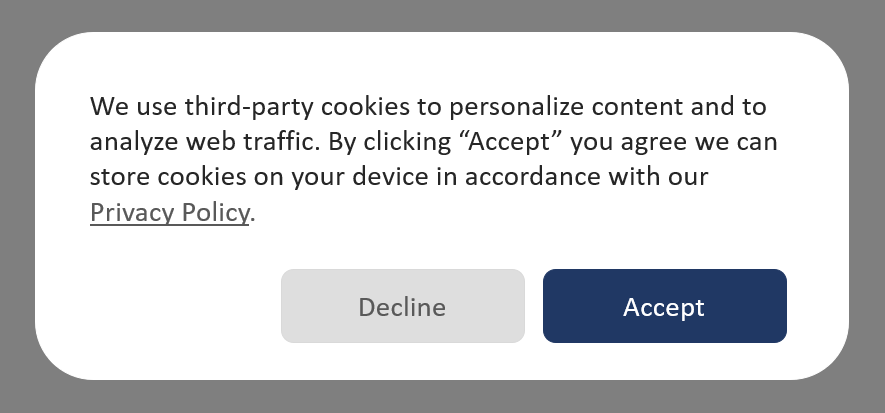“And so it begins.”
In the first few quiet days of 2024, Google began disabling cookies for 1% of users on its flagship browser, Chrome.
Considering that Chrome is the primary browser for 64.73% of global Internet users according to StatCounter, that’s no ordinary 1%.
The future has arrived. Not with a bang, but a whisper.
The Cookieless Future is Here
We’ve been talking openly about the cookieless-future for years now.
For this author, one of the first articles I wrote for NetLine dealt directly with this topic four years ago.
“What Google’s Cookie-Tracking News Means for B2B Marketers”
Despite nearly half a decade of lead time and discussion, many professionals and businesses find themselves unsure of what exactly wil happen.
You need look no further than LinkedIn to see how this is playing out.
What’s truly remarkable is just how little understanding there is of what’s to come at a macro level.
Why Now?
In October 2023, Search Engine Journal wrote the following about Google’s deprecation plans.
“Google wants to eliminate this tracking capability while introducing new standards that support key needs like fraud prevention and delivering relevant ads.
Google says this change will improve user privacy and security while providing website owners tools to sustain their businesses without third-party cookies.”
We can’t pretend that Google will do everything in its power to protect your privacy. But the move does align with the actions of its users.
Reject All Cookies

One of the biggest catalysts for this change has been the behavior of consumers.
Like millions of others, anytime I’m presented with the opportunity to reject all cookies like an unwelcome invitation to prom, I do it.
Sorry, Marcy, but I don’t want you to follow me.
I’m sure your behavior has been quite similar to mine in recent months and years.
Because of this (long before Google announced its intention to disable cookies), businesses have had to pivot.
Finding New Ways to Reach Your Target Audience
The shift towards enhanced user privacy, while challenging, presents an opportunity for innovation in the greater marketing and advertising ecosystem.
It’s crucial for website owners, especially those in our field, to proactively audit their current use of cookies.
This audit is the first step in preparing for the upcoming changes in 2024, ensuring that their services continue to operate effectively and efficiently in a post-third-party cookie environment.
From there, businesses have options for how to best carry forward.
Prioritizing First-Party Data in Today’s Privacy-Conscious World
What was written in 2019 still holds true today. When obstacles present themselves, so too do opportunities.
Google’s actions affect millions of businesses and billions of consumers, but your marketing shouldn’t be limited by one organization’s decisions.
Let’s review some of your options before the cookies continue to crumble.
Prioritizing First-Party Data in Today’s Privacy-Conscious World
In our increasingly privacy-conscious world, the importance of gathering first-party, fully-consented data cannot be overstated.
As established by CASL over a decade ago, consent is crucial for when building a marketing communications approach. With consent, your messages are not just delivered; they’re welcomed, enhancing the likelihood of acceptance with each interaction.
Re-evaluating Your Database
If your customer and audience data could talk, what stories would it tell?
Beyond the surface-level metrics, do you know what truly drives user engagement, lead generation, and sales conversions?
Understanding these narratives is key in applying a ‘first-party data-first’ approach effectively.
Examine your current data reserves and be honest with yourself and your team as to whether your database is healthy enough for the Privacy Present and Future.
Enhancing Acquisition Strategies
Historically, retargeting emerged as a solution to the limitations of traditional display advertising.
While retargeting can still be a valuable tactic, it cannot be the primary method of staying in front of your target buyer.
Instead, focus on investing in high-quality, content-driven marketing strategies that resonate and deliver value in the right contexts.
NetLine’s Portal, for instance, presents a prime opportunity for B2B businesses seeking meaningful engagement. These buyers voluntarily share their first-party data as they engage with over 700,000 content pieces monthly, drawn from a pool of more than 125 million visitors.
A New Era of Data Transparency
Contrast our approach with the practices of numerous B2B ‘Intent’ players, who often trade consumer data without proper consent or disclosure, and the significance of this shift becomes clear.
Embracing transparent, consent-based data practices is vital not only for consumer trust but also for the credibility and future of the AdTech industry.”
Top 10 Tactics for Flourishing in a Post-Cookie Digital Landscape
Beyond recalibrating to focus on the needs of a more privacy-conscious public, there are a variety of methods you can use to get the buyer information you need.
- Embrace User Empathy
Always view your strategies through the user’s lens. Respecting and protecting user data as if it were your own is fundamental in today’s digital landscape. - Embrace First-Party Data
We might be approaching broken record territory, but we have good reason for stressing this.
Implement effective data capture mechanisms within your organization.
Maintain a streamlined CRM system, ensuring alignment between sales and marketing definitions, and conduct mixed-method research to refine your advertising efforts. - Implement Contextual Advertising
Align your digital content with your advertising messages. Develop SEO strategies that resonate with your users’ needs and their journey. - Capitalize on Owned Media Channels
Focus on building and controlling your own channels.
This reduces dependence on external platforms and enhances direct engagement with your audience. - Utilize Data Clean Rooms
Employ data clean rooms to safely analyze and compare your first-party data with compliant third-party data, uncovering valuable insights and patterns. - Optimize Your CRM
Standardize KPIs and CRM management across your organization.
A well-managed CRM leads to a deeper understanding of customer segments, enhancing the effectiveness of your campaigns. - Develop Advanced Statistical Models
Invest time in identifying or creating the most suitable marketing mix models for your business.
Utilize a combination of models to accurately attribute success across various channels. - Explore AI for Predictive Analysis
Leverage AI tools for predictive modeling in marketing.
Tools like Robyn or Google’s free models can significantly improve your marketing investment’s effectiveness. - Adapt to a Privacy-First Digital World
Accept the new normal of a privacy-focused internet with reduced tracking capabilities.
Return to marketing basics, employing mixed-method research and robust statistical models. - Stay Compliant with Data Privacy Laws
Regularly update your knowledge and compliance with data privacy regulations.
Neglecting this aspect can lead to legal penalties and damage trust between your brand and its users.
CONCLUSION
The days of third-party cookies are numbered. If you’re still basing your 2024 marketing and advertising plans around the capabilities they provide, you’re well behind the eight ball.
Take advantage of the new, private frontier and bolster your first-party and intent data strategies.
Without them, you’ll be left with nothing but crumbs.
And no one is ever happy with crumbs.

